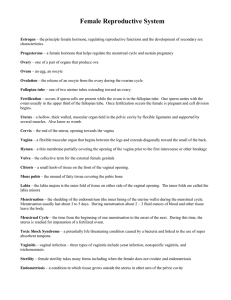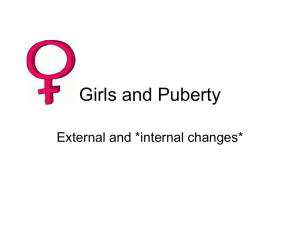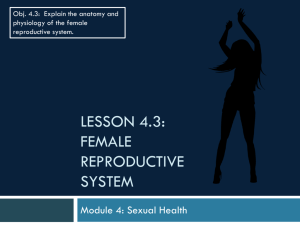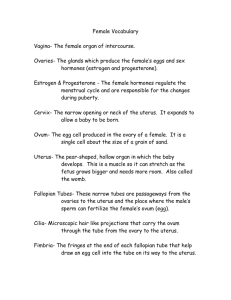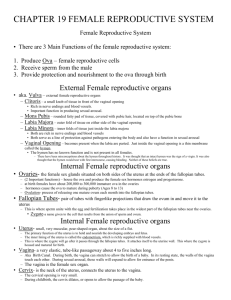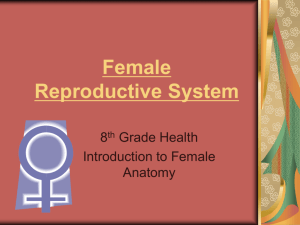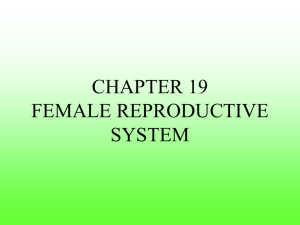The Reproductive System
advertisement
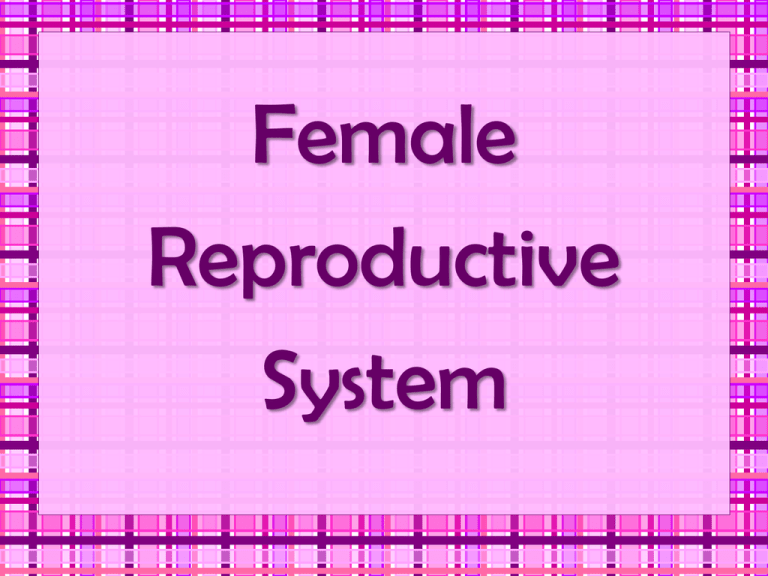
Female Reproductive System • An essential function of all living things is reproduction. • Reproduction- the process by which life continues from one generation to the next. • In humans, as in many other species, reproduction results from the union of two sex cells, one from the male and one from the female. The Reproductive SystemThe system of organs involved in producing offspring The female reproductive system has several functions: 1. It produces female sex hormones and stores female reproductive cells (ova). 2. The uterus nourishes and protects the fertilized ovum from conception until birth. Female reproductive system: • • • • • • Fallopian Tubes Ovaries Endometrium Uterus Vagina Cervix Ovaries Female sex glands that store the ova and produce female sex hormones. • At birth a female’s ovaries contain more than 400,000 immature eggs (ova). • Beginning at puberty, one ovum matures each month Ovulation The process of releasing a mature ovum into the fallopian tube each month. – The right ovary will release a mature ovum one month, and the left ovary will release one the next month. Fallopian Tubes • A pair of tubes with fingerlike projections that draw in the ovum. Fallopian tubes continued…… • Tiny hair like structures called cilia work along with the muscular contractions to move the ovum along inside the fallopian tubes. Endometrium The lining of the uterus (the womb). It grows and sheds each month during the menstrual cycle. • The endometrium then grows back and slowly gets thicker and thicker until the next period when it is once again shed. Uterus A hollow muscular pear-shaped organ inside a female’s body. • It nourishes and protects the fertilized ovum from conception until birth. Vagina A muscular elastic passageway that extends from the uterus to the outside of the body. • This is where menstrual blood, vaginal fluids and babies leave the body. Cervix The lower part of the uterus that connects the uterus to the vagina. • The cervical canal passes through the cervix, allowing the menstrual period and fetus to pass from the uterus into the vagina, and sperm to pass from the vagina into the uterus MenstruationShedding of the uterus lining. Menstruation continued: • A period is when a woman's body releases tissue it no longer needs. • This tissue comes from the uterus, which is where a baby (fetus) develops in the female body. • Every month or so, the uterus lining gets thicker. This is to prepare for a fertilized egg if the woman becomes pregnant. Menstruation continued: • If the egg doesn't get fertilized, that lining is released from the body through the vagina. This is called menstruation. • So when a girl has her period she is not "bleeding"-- her body is just getting rid of a small amount of blood and some un-needed tissue. It is a natural, normal body process. The Menstrual Cycle (Menstruation is part of the menstrual cycle) A cycle is counted from the first day of one period to the first day of the next period. • The average menstrual cycle is 28 days long Menstrual Cycle continued: • In the first half of the cycle, levels of estrogen (the female hormone) start to rise and make the lining of the uterus (womb) grow and thicken. • At the same time, an egg (ovum) in one of the ovaries starts to mature. • At about day 14 of a typical 28-day cycle, the egg leaves the ovary. This is called ovulation The Period Problems related to menstruation: • Menstrual cramps - (constriction and tightening of the uterine muscle) occur at the beginning of the period. • Premenstrual syndrome (PMS) – caused by hormonal changes. May be experienced 1 – 2 weeks before. Symptoms include: irritability, bloating, weight gain, mood swings, and fatigue. Problems related to menstruation continued: • Toxic Shock Syndrome (TSS) – rare but serious bacterial infection that affects the immune system and the liver and can be fatal. To reduce risk, CHANGE TAMPONS OFTEN! • Symptoms include: fever, vomiting, diarrhea and dizziness. Menopause A time in a women’s life when her period stops. • It is a normal change in a woman's body. A woman has reached menopause when she has not had a period for 12 months in a row (and there are no other causes, such as pregnancy or illness, for this change). Normally happens between the ages of 45- 55 Care of the Female Reproductive System • Bathe Regularly • During menstruation, pads and tampons must be changed every few hours. • Practice Abstinence • Abstain from sexual activity to avoid unplanned pregnancy and STD’s.
